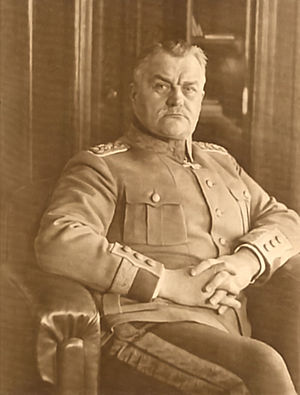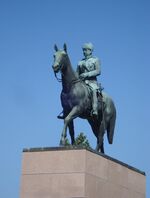Artemi Kapanen
Grand Marshall Artemi Kapanen OL, OWRT | |
|---|---|
 Grand Marshall Kapanen, 1946 | |
| Birth name | Artemi Matti Rasmus Kapanen |
| Nickname(s) | "The Black Eagle of the Motherland" |
| Born | October 16, 1880 Skudenesstrøm, Glyra, Kingdom of Talvistova |
| Died | December 10, 1947 (age 67) Ljustad, Osta, Kingdom of Talvistova |
| Allegiance | |
| Service/ | Royal Talvistovan Army |
| Years of service | 1902-1947 |
| Rank | |
| Commands held | 2nd Lord's Cavalry, Guards of Bedrosia |
| Battles/wars | First Great War, Second Great War |
| Awards |
|
| Memorials | Kapanen Military College |
| Spouse(s) | Lumi Mesikämmen |
| Signature | |
Grand Marshall Artemi Matti Rasmus Kapanen was a Talvistovan military leader. Kapanen served as an officer in the First Great War and then went on to serve as supreme commander of all Talvistovan Forces during the Second Great War.
In a military historical society survey 50 years after his death in 1997, he was rated as the greatest military leader in Talvistovan history, and the greatest talvistovan of all time, next to king Juren II. He is the only man in Talvistovan history to ever hold the ceremonial rank of Grand Marshall.
Early Life
Kapanen was born in the small town of Skudenesstrøm, in the province of Glyra, to Jemina & Emil Kapanen, as the youngest of 5 children. As a young man, Artemi showed promise as a marksman and soldier, as he won several provincial shooting contests as his youth, and his renowned skill hunting in the woods surrounding his home town. Due to this, in combination with his love of history and his ability in the youth corps, he earned an appointment to the Glyra Provincial Military academy, where he would study in order to be commissioned as a Junior Lieutenant in the Royal Talvistovan Army
Education and Early Military Career
Artemi was enrolled in the Glyra Provincial Military Academy at the age of 18 in 1898, where he would compete on the academy riflery team as well as it's wrestling team.
During his freshman year, Kapanen found several issues with his fellow students, due to his lack of family lineage, as it was wildly uncommon for anyone to gain entrance into a military academy without the a previous family member having attended it, as well as being from a tiny fairly irrelevant village in the mountains.
This regularly found him in the campus brig, where he met a female cook named Lumi Mesikämmen, who he would marry later that year in 1898, and stay with until his death in 1947.
Instead of being thrown out do to his penchant for fighting, the Headmaster of the Academy, one Admiral Julius Jokinen, who would later go on to be the namesake of the only carrier in service with to Royal Talvistovan Navy, decided that the fury and grit he displayed could serve as useful as a leader in future military conflicts, and allowed him to continue to study. This decision would go on to pay off massively, as 3 years later, in 1902, would graduate as the salutatorian of his class, an honor he would hold in very high regard up until his death, and once remarked, "That damned ring was the hardest thing I've ever had to get."
Following his graduation, he was commissioned as a second lieutenant as the 21st Cavalry Regiment, a post that he often lamented due to the lack of nearby forests, and warm climate. However, he was able to push through, and his company, K company, which is now refered to as Kapanen Company, was seen as the best in the regiment and quickly helped him rise to the rank of Junior Captain. He then bounced around various cavalry regiments up until 1910, when accepted his first command position, as Commandant of the 1st Reserve Battalion. He would carry this command up until 1915, where, now a Senior Captain, would accept command of the 3rd Light Horse Guards during the First Great War.
First Great War
Interwar Period
After the removal of Talvistova from the First Great War, Kapanen saw that the military needed to modernize if it ever wanted to be able to be competitive with future military conflict. His primary focus was trying to get to the adaptation of a semi-automatic rifle, and to embrace vehicle based warfare that he saw would be necessary.
He quickly convinced the Minstry of Defense using his war pedigree to his advantage, to allow him to contact various arms manufacturers to look into the possiblity of replacing bolt action rifles. Eventually he was able to put together a design in cooperation with the Heikkinen Brothers Munitions Company, which would result in the adoption of the HBM-1918 rifle in 1919.
He then turned his attention toward his other fear that he saw rear it's head: Mechanization. He saw what tanks could do, and did not want Talvistova to be left behind. So he called upon his friendship with the Glyra Automotive Company to begin production on the Krigsvagen, which would become the first light tank to enter service in the Royal Talvistovan Armor Corps. This would move towards achieving his ultimate goal
Second Great War
Personal Life
Kapanen met his wife, Lumi Mesikämmen, while in the campus brig at the Glyra Military Academy. They married in 1898, in his home town, in a traditional orthodox ceremony. They had one child together, a daughter named Katja, who was born in 1910. They also had another child, a son named Julius, after the Admiral who allowed him to stay at the Military academy, who was born in 1911, but died 6 months after being born due to complications. He and his wife would stay together until his death.
For most of his life, he lived on his Family ranch in Skudenesstrøm, which is now preserved as a historical site.
Death
In 1946, Kapanen fell ill with a severe bout of fatigue and dehydration, which was initially misdiagnosed to being due to his constant travel in combination with his age. He seemingly recovered, and continued with his service as Grand Marshall. When he returned, however, after the surrender of the Core, he looked vastly different. His skin has darkened, and he was plagued by bouts of vomiting, fever, and lethargy. This would eventually end up killing him in december of 1947, in what is later unanimously agreed by physicians to be Addison's Disease.
His funeral was preceded by a massive horse drawn parade, and the wake was held in his hometown of Skudenesstrøm It was attended by 5,000 people. By his wishes, he was cremated, and his ashes where scattered over what is now the Kapanen Military Academy.
Legacy
As previously mentioned, he is rated as one of the greatest Talvistovans to ever live, and has the monuments to last.
The Military College in Lonlond, Glyra is named the Marshall Kapanen Military College in his honor.
Several statues, most notably the statue potraying him on horseback in Victory Square in Ljustad, have been erected bearing his name.
The highest award in the Talvistovan Army is now known as the Kapanen Cross.

